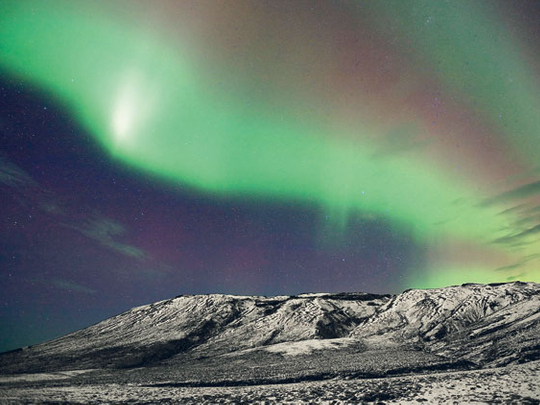
The mercury has dipped to way below zero. The cold is gnawing at my hands through my gloves. And the wind is roaring at Mount Skalafell, outraged that anyone should take to its 1,800-foot summit in such weather. I barely notice. Because above, the sky is moving. Splattered against the stars, a hazy patch of white is swirling like milk poured into black coffee.
A few hours earlier, my guide Ragnar Lovdal, had predicted this, almost sniffing the air as he declared that the cloudless skies would hold their clarity into the evening. He was right. And there they are: the northern lights.
In theory, I should be disappointed. I've listened to the dry science, to the explanation that, far from being supernatural, this iridescent display occurs when particles emitted by the Sun hit the magnetic fields above the Earth's poles.
And this is by no means the most dazzling example of aurora borealis, a phenomenon that can dance through a half-rainbow of yellows, greens and reds, depending on the conditions and the viewer's proximity to the top of the globe.
Yet I'm elated. After three nights under a shrouded firmament, we are finally in the presence of something that seems otherworldly.
Not only are the northern lights utterly at home here — visible from October to early March — but Iceland is a country that defines the word "otherworldly".
Dramatic views
A day before my date with the northern lights, I join Ragnar on the Golden Circle — a 306-kilometre route that links the key sights in the south and centre of the island.
This charred volcanic panorama is all the more dramatic for being seen in the darkest season.
The Sun rises sluggishly over Iceland in winter, scraping its belly on the horizon at about 10am, then hanging low. The effect is an almost lunar, wan light ebbing over cooled lava and basalt.
Hekla, the 4,882-foot volcano, has erupted four times in 30 years. In medieval times, the locals regarded its caldera as the mouth of destruction. But something about the scene binds it more to the 9th century, when Norse settlers first came ashore. This is a realm of the pagan deities, of Thor, Odin and Freyja.
This impression stays with me as we tour the Golden Circle — not least at Gullfoss, a three-step waterfall, where the Hvita River churns and spits through a steep canyon. Geysir, meanwhile, is a geyser of such fame that its name has become a byword but, nowadays, its thunder has been stolen by Strokkur nearby, which fires loud jets of water from its crater every five minutes.
As I approach the Blue Lagoon, 48 kilometres southwest of Reykjavik, the Sun is compressed to a flat disc behind the steam belching from the lava-heated bathing area. As I dig my toes into the soft ooze, I ponder that Iceland is not so hard after all.



